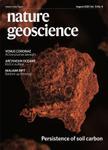版权所有:内蒙古大学图书馆 技术提供:维普资讯• 智图
内蒙古自治区呼和浩特市赛罕区大学西街235号 邮编: 010021

作者机构:Univ Colorado Dept Phys Boulder CO 80309 USA
出 版 物:《NATURE GEOSCIENCE》 (Nat. Geosci.)
年 卷 期:2018年第11卷第11期
页 面:876-+页
核心收录:
学科分类:07[理学] 0708[理学-地球物理学]
基 金:National Science Foundation [1135382, 1645245, 1450181] Directorate For Geosciences Division Of Earth Sciences Funding Source: National Science Foundation Division Of Earth Sciences Directorate For Geosciences [1450181, 1645245] Funding Source: National Science Foundation
摘 要:The linear structures of seismically fast anomalies, often interpreted as subducted slabs, in the southern Asia and circum-Pacific lower mantle provided strong evidence for the whole mantle convection model. However, recent seismic studies have consistently shown that subducted slabs are deflected horizontally for large distances in mantle transition zone in the western Pacific and other subduction zones, suggesting that the slabs meet significant resistance to their descending motion and become stagnant in the transition zone. This poses challenges to the whole mantle convection model and also brings the origin of stagnant slabs into question. Here, using a global mantle convection model with realistic spine-post-spinel phase change (-2 MPa K-1 Clapeyron slope) and plate motion history, we demonstrate that the observed stagnant slabs in the transition zone and other slab structures in the lower mantle can be explained by the presence of a thin, weak layer at the phase change boundary that was suggested by mineral physics and geoid modelling studies. Our study also shows that the stagnant slabs mostly result from subduction in the past 20-30 million years, confirming the transient nature of slab stagnation and phase change dynamics on timescales of tens of millions of years from previous studies.